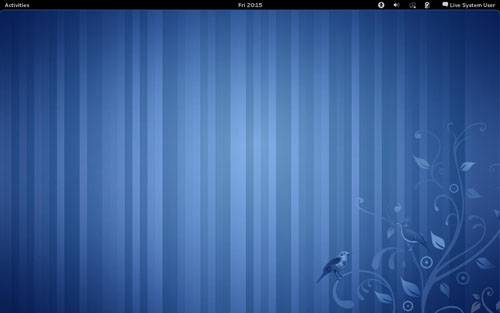- Qualcomm Launches Snapdragon 4 Gen 2 Mobile Platform
- AMD Launches Ryzen PRO 7000 Series Mobile & Desktop Platform
- Intel Launches Sleek Single-Slot Arc Pro A60 Workstation Graphics Card
- NVIDIA Announces Latest Ada Lovelace Additions: GeForce RTX 4060 Ti & RTX 4060
- Maxon Redshift With AMD Radeon GPU Rendering Support Now Available
An In-Depth Look at Fedora 15

Fedora has long been touted as being one of the most professional, stable, cutting-edge distros out there, and seeing as though its latest version brings GNOME 3 along for the ride, I couldn’t help but download and install it. I’ve since used Fedora 15 for an entire month, so read on as I take a look at this release from all angles.
Page 1 – Introduction
Since its initial release in 2003, Fedora users have been treated to two main releases each year, with the most recent having been launched late last month. Thanks to this regular release schedule, it’s not often that one launch feels more special than another, but Fedora 15 is different. A big reason? GNOME 3.
Since its own launch a couple of months ago, GNOME 3 has received quite a bit of flak for taking a step backwards, despite being arguably the most attractive desktop environment to ever grace a Linux OS. The Fedora team took a huge risk setting GNOME 3 as the default desktop, which in itself has raised a fair amount of controversy.
Being that I haven’t given Fedora a fair test since FC6, nor had a chance to test out GNOME 3 up to this point, it felt like there was no better opportunity than the launch of Fedora ‘Lovelock’ to kill two birds with one stone. As I did with my in-depth look at Ubuntu 11.04, the focus here will be mostly on Fedora itself, but I’ll be dedicating a page to talk about GNOME 3.

First things first; what sets Fedora apart from the crowd? For starters, it’s sponsored by one of the oldest and most financially successful Linux companies around, Red Hat. In fact, the entire reason Fedora came to be was due to the cancellation of Red Hat’s desktop variant in 2003. With this relationship, Red Hat and Fedora feed off of each other and share integral technologies. Fedora, though, can boast things such as a lack of cost, frequent releases, and a community that’s integral to its success.
Fedora has a couple of strong “selling-points”, including the adoption of cutting-edge technologies and a goal of being 100% “free”, as in libre, or “freedom”. In taking the Fedora leap, you can be assured that there are no proprietary or commercial packages installed – important to those who care a lot about true freedom in software.
That “free” advantage isn’t for the feint of heart, however, as more casual users, especially those coming from Windows, could be in for a surprise with the lack of MP3, Adobe Flash, official AMD / NVIDIA drivers and more. If it’s not 100% free as per a software’s given license, then it’s not included in Fedora. While I am not opposed to installing commercial / proprietary software on any of my Linux boxes, I am at the same time thankful for the dedication to free software by the Fedora team.
Aside from the free aspect, Fedora aims to be the most stable distro available, a real “professionals” OS, excellent for developers but not too overwhelming for the casual user. At first glance, one might be confused as to the lack of a ‘server’ version, but it’s clear that the server realm isn’t a major focus here, though the OS can still be used for those purposes. At the same time, CentOS, another Red Hat derived distro, would be a better bet as its major focus is in fact servers (all of Techgage’s servers run on CentOS).
What’s New?
Aside from the obvious inclusion of GNOME 3, Fedora 15 introduces the option of using the Btrfs (butter FS) file system, something that’s set to become default in Fedora 16. Btrfs’ goal is to offer unparalleled data security by introducing things like checksums and snapshots, and also enables disk pooling. Btrfs even goes as far to support the SSD TRIM command, so there could be little-to-no reason to stick to ext4, except for the pursuit of absolute performance.
Another cool addition is ABRT (Automatic Bug Reporting Tool), an enhanced crash reporter that doesn’t require you to install debugging tools prior to sending in a bug report. Instead, you have the option to send the dump to a server that will handle it, making the entire process simple and pain-free. In the couple of times I’ve tested this, I didn’t have the best of luck, but there may just be launch kinks to work out.
To help improve start times, Fedora 15 becomes the first distro to default to the systemd init daemon. It aims to reduce shell overhead and can load services in parallel, so the benefits are obvious. With other distros having pondered a move to systemd for a while, Fedora again proves that it’s a cutting-edge distro.
Other improvements and adjustments include a refined SELinux trouble-shooter, better compressed Live CDs, improved power management, a switch of OpenOffice to LibreOffice, and of course, a slew of regular package updates.
Select packages include the 2.6.38.6 Linux kernel, GCC 4.6.0, GRUB 0.97, KDE 4.6.2 and Xfce 4.8.0 (through yum or the specific install discs), MySQL 5.5.10, PHP 5.3.6, Python 2.7.1, SAMBA 3.5.8, udev 167, and xorg-server 1.10.1. A much more thorough list can be found at DistroWatch.
Support our efforts! With ad revenue at an all-time low for written websites, we're relying more than ever on reader support to help us continue putting so much effort into this type of content. You can support us by becoming a Patron, or by using our Amazon shopping affiliate links listed through our articles. Thanks for your support!






